Infantry Equipment, Pattern 1914 - Equipment Carriers
Carriers, intrenching tool: Heads, 1st issue

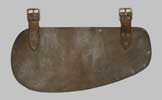 The Pattern 1914 Intrenching tool carrier was introduced with the Infantry Equipment, Pattern 1914 in List of Changes entry L. of C. 16977, dated 30th August 1914. It is designed to carry the head of the Pattern 1908 Entrenching (or 'Intrenching') tool, also know as the Sirhind tool. This is the best example we've found of an early Carrier in Service Dress colour, and without the added rivets. This same Carrier, by the way, is shown on our page on Pattern 1914 Colour, shown against a Service Dress Tunic. From the John Bodsworth Collection, photo © John Bodsworth 2011.
The Pattern 1914 Intrenching tool carrier was introduced with the Infantry Equipment, Pattern 1914 in List of Changes entry L. of C. 16977, dated 30th August 1914. It is designed to carry the head of the Pattern 1908 Entrenching (or 'Intrenching') tool, also know as the Sirhind tool. This is the best example we've found of an early Carrier in Service Dress colour, and without the added rivets. This same Carrier, by the way, is shown on our page on Pattern 1914 Colour, shown against a Service Dress Tunic. From the John Bodsworth Collection, photo © John Bodsworth 2011.
Carriers, intrenching tool: Heads, 2nd issue
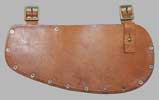
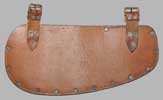 The Pattern 1914 Intrenching tool carrier was introduced with the Infantry Equipment, Pattern 1914 in List of Changes entry L. of C. 16977, dated 30th August 1914. It is designed to carry the head of the Pattern 1908 Entrenching (or 'Intrenching') tool, also know as the Sirhind tool. As with all leather parts of the Pattern 1914 Infantry Equipment, the colour was changed from Service Dress to London Brown by List of Changes entry L. of C. 17219, 31st December 1914, amended 30th March 1915. The same L. of C. also modified the Carrier by adding six additional rivets around the bottom. This 1915 dated example has the additional rivets. From the Paul Hannon Collection, photos © Paul Hannon 2011.
The Pattern 1914 Intrenching tool carrier was introduced with the Infantry Equipment, Pattern 1914 in List of Changes entry L. of C. 16977, dated 30th August 1914. It is designed to carry the head of the Pattern 1908 Entrenching (or 'Intrenching') tool, also know as the Sirhind tool. As with all leather parts of the Pattern 1914 Infantry Equipment, the colour was changed from Service Dress to London Brown by List of Changes entry L. of C. 17219, 31st December 1914, amended 30th March 1915. The same L. of C. also modified the Carrier by adding six additional rivets around the bottom. This 1915 dated example has the additional rivets. From the Paul Hannon Collection, photos © Paul Hannon 2011.
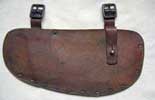
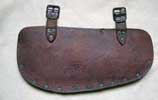 Another example of the 2nd issue Intrenching tool carrier. Although it is much darker in colour than the one shown above, we consider that this one is also London brown. After ninety-five years of use, dirt, oil, and exposure, the leather has darkened. This example is British made, but is not maker marked or dated. It is owned by a British collector who wished to remain anonymous.
Another example of the 2nd issue Intrenching tool carrier. Although it is much darker in colour than the one shown above, we consider that this one is also London brown. After ninety-five years of use, dirt, oil, and exposure, the leather has darkened. This example is British made, but is not maker marked or dated. It is owned by a British collector who wished to remain anonymous.
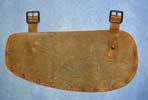
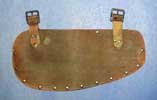
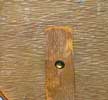 This Intrenching tool carrier is an example of the Pattern 1914 equipment made under contract in the U.S.A. The most obvious difference between British and U.S. made Patt. '14 items is the type of rivets. British pieces were made using the tin plated copper "hose rivets" commonly seen on British military equipment, whilst the American pieces used one piece steel rivets. This example has the later style additional rivets around the bottom. It is maker marked "Cook" and dated 1915. From the Ed Storey Collection. Photographs © Ed Storey 2008.
This Intrenching tool carrier is an example of the Pattern 1914 equipment made under contract in the U.S.A. The most obvious difference between British and U.S. made Patt. '14 items is the type of rivets. British pieces were made using the tin plated copper "hose rivets" commonly seen on British military equipment, whilst the American pieces used one piece steel rivets. This example has the later style additional rivets around the bottom. It is maker marked "Cook" and dated 1915. From the Ed Storey Collection. Photographs © Ed Storey 2008.
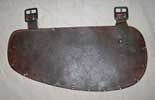
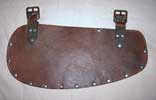
 Another US made example. This one is also maker marked "Cook" and dated 1915. Compare with the example above. They are identical in form, but this one has darkened considerably since 1915. From the Chris Pollendine Collection, photos © Chris Pollendine 2011.
Another US made example. This one is also maker marked "Cook" and dated 1915. Compare with the example above. They are identical in form, but this one has darkened considerably since 1915. From the Chris Pollendine Collection, photos © Chris Pollendine 2011.
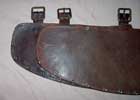 A side-by-side comparison. Both Carriers are maker marked "Cook" and dated 1915. From the Chris Pollendine Collection, photo © Chris Pollendine 2011.
A side-by-side comparison. Both Carriers are maker marked "Cook" and dated 1915. From the Chris Pollendine Collection, photo © Chris Pollendine 2011.

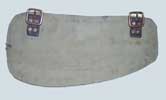
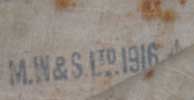 In form, this is a Pattern 1914 Intrenching tool carrier, but with a web bag! There were certainly other Patt. '14 items with web envelopes, such as Haversacks and Packs, but those are clearly documented in the L. of C.'s. We haven't found any List of Changes references to this. The piece is maker marked "M.W. & S. Ltd." and dated 1916, which is a bit late (although not unprecedentedly so) for Patt. '14 production. The crown fastener is plain, which looks dodgy, but it is true that a number of Wrights made Patt. '08 Intrenching tool carriers with 1916 dates show the same feature. When we look at it, it seems pukkah, and if it was a known form we'd have no problem declaring it genuine. We can state that it WAS made this way; the stitching is clean and the piece has not been modified. Interestingly, it is broad arrow marked.
In form, this is a Pattern 1914 Intrenching tool carrier, but with a web bag! There were certainly other Patt. '14 items with web envelopes, such as Haversacks and Packs, but those are clearly documented in the L. of C.'s. We haven't found any List of Changes references to this. The piece is maker marked "M.W. & S. Ltd." and dated 1916, which is a bit late (although not unprecedentedly so) for Patt. '14 production. The crown fastener is plain, which looks dodgy, but it is true that a number of Wrights made Patt. '08 Intrenching tool carriers with 1916 dates show the same feature. When we look at it, it seems pukkah, and if it was a known form we'd have no problem declaring it genuine. We can state that it WAS made this way; the stitching is clean and the piece has not been modified. Interestingly, it is broad arrow marked.

 Details of the front leather chape connection, clearly showing that it has not been modified.
Details of the front leather chape connection, clearly showing that it has not been modified.
KW Staffer Chris Pollendine says that it's "certainly genuine. Third one I've seen. There are at least two complete sets I know of, of P14 made entirely out of web, pouches, belt, everything. One is in a museum in France, which I have studied personally; I believe the other is in the IWM, but can't recall for certain. I may have some pics of the French set..." We are looking forward to those pictures, Chris!
Let's see - a web copy of a leather copy of a web Carrier, and you certainly don't finish up where you started. Is this the accoutrement version of Chinese Whispers?
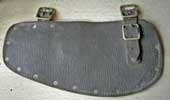
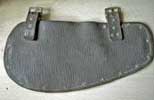
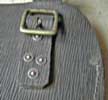 Chris Pollendine has also sent in these pictures of this oddball variant of the Pattern 1914 Intrenching tool carrier. He has this to say about his discovery: "Marked COOK 1916 - exact same mark, font etc as US p14 by them. London brown, rivets the wrong way round, not to mention the closing buckle. Whatever it is, it's been made this way, clearly, & not altered." The only thng we can see to add to that, other than that it appears genuine, is that it has British style hose rivets. That would be unique if it's actually US made. It's too good to be fake and too way off beam for anybody to want to fake it! Ergo - it's for real. False U.S. start, before inspector said "Oi!"? Brief "improvement", before being told to do it to Spec? Can anyone supply additional information?
Chris Pollendine has also sent in these pictures of this oddball variant of the Pattern 1914 Intrenching tool carrier. He has this to say about his discovery: "Marked COOK 1916 - exact same mark, font etc as US p14 by them. London brown, rivets the wrong way round, not to mention the closing buckle. Whatever it is, it's been made this way, clearly, & not altered." The only thng we can see to add to that, other than that it appears genuine, is that it has British style hose rivets. That would be unique if it's actually US made. It's too good to be fake and too way off beam for anybody to want to fake it! Ergo - it's for real. False U.S. start, before inspector said "Oi!"? Brief "improvement", before being told to do it to Spec? Can anyone supply additional information?
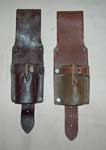
 The Pattern 1914 Bayonet frog was introduced with the Infantry Equipment, Pattern 1914 in List of Changes entry L. of C. 16977, dated 30th August 1914. It is designed to carry either the Pattern 1888 or Pattern 1907 Bayonet in scabbard. The 1-inch wide tab at the rear is used to attach the Helve carrier. As with all leather parts of the Pattern 1914 Infantry Equipment, the colour was changed from Service Dress to the darker London Brown by List of Changes entry L. of C. 17219, acceptance dates 31 December 1914 and 30 March 1915. The same L. of C. also modified the Frog by adding two additional rivets at each bottom corner. These Frogs, from the Chris Pollendine Collection, are examples of British (left) and American (right) production. The maker's mark on the British example is unclear, but it is dated 1915. The American Frog is maker marked "John Boyle & Co." and dated 1915. Photos © Chris Pollendine 2011.
The Pattern 1914 Bayonet frog was introduced with the Infantry Equipment, Pattern 1914 in List of Changes entry L. of C. 16977, dated 30th August 1914. It is designed to carry either the Pattern 1888 or Pattern 1907 Bayonet in scabbard. The 1-inch wide tab at the rear is used to attach the Helve carrier. As with all leather parts of the Pattern 1914 Infantry Equipment, the colour was changed from Service Dress to the darker London Brown by List of Changes entry L. of C. 17219, acceptance dates 31 December 1914 and 30 March 1915. The same L. of C. also modified the Frog by adding two additional rivets at each bottom corner. These Frogs, from the Chris Pollendine Collection, are examples of British (left) and American (right) production. The maker's mark on the British example is unclear, but it is dated 1915. The American Frog is maker marked "John Boyle & Co." and dated 1915. Photos © Chris Pollendine 2011.

 This is an another American made Bayonet frog, made in Service Dress leather with the typical steel rivets. Note that the strap to attach the Helve carrier has been cut off. This is a commonly seen modification, presumably made after the Sirhind tool was made obsolete in 1923. Patt. '14 equipment was withdrawn from service in 1921, but Frogs were exempted by A.C.I. 349, issued 31 May, 1921, being issued in lieu of buff leather Frogs, and so were withdrawn and returned to store. From the Steve Hewitt Collection, photographs © Steve Hewitt 2009.
This is an another American made Bayonet frog, made in Service Dress leather with the typical steel rivets. Note that the strap to attach the Helve carrier has been cut off. This is a commonly seen modification, presumably made after the Sirhind tool was made obsolete in 1923. Patt. '14 equipment was withdrawn from service in 1921, but Frogs were exempted by A.C.I. 349, issued 31 May, 1921, being issued in lieu of buff leather Frogs, and so were withdrawn and returned to store. From the Steve Hewitt Collection, photographs © Steve Hewitt 2009.
Carriers, intrenching tool: Helve


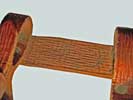 The Pattern 1914 Carrier, Intrenching tool: Helve was introduced with the Infantry Equipment, Pattern 1914 in List of Changes entry L. of C. 16977, dated 30th August 1914. It is designed to carry the Helve of the Pattern 1908 Entrenching (or 'Intrenching') tool, also know as the Sirhind tool. The Carrier slides over the Bayonet scabbard and buckles to the Frog. The Helve fits into the loops in front of the Scabbard. Except for the colour, the Helve carrier remained unchanged throughout its service life. This British made example is maker marked "J.B. Brooks & Co." and dated 1915. From the Grant Napier Collection, photographs © Grant Napier 2008.
The Pattern 1914 Carrier, Intrenching tool: Helve was introduced with the Infantry Equipment, Pattern 1914 in List of Changes entry L. of C. 16977, dated 30th August 1914. It is designed to carry the Helve of the Pattern 1908 Entrenching (or 'Intrenching') tool, also know as the Sirhind tool. The Carrier slides over the Bayonet scabbard and buckles to the Frog. The Helve fits into the loops in front of the Scabbard. Except for the colour, the Helve carrier remained unchanged throughout its service life. This British made example is maker marked "J.B. Brooks & Co." and dated 1915. From the Grant Napier Collection, photographs © Grant Napier 2008.



 Additional examples of British made Helve carriers. The Carrier far left is dated 1915, but has no clear maker's mark. The one near left is neither maker marked nor dated. From the Chris Pollendine Collection, photos © Chris Pollendine 2011.
Additional examples of British made Helve carriers. The Carrier far left is dated 1915, but has no clear maker's mark. The one near left is neither maker marked nor dated. From the Chris Pollendine Collection, photos © Chris Pollendine 2011.

 An American made Patt. '14 Helve carrier. Note the distinctive steel rivets. From the Steve Hewitt Collection, photographs © Steve Hewitt 2009.
An American made Patt. '14 Helve carrier. Note the distinctive steel rivets. From the Steve Hewitt Collection, photographs © Steve Hewitt 2009.
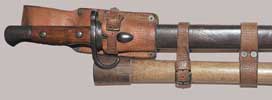 This picture shows the Frog and Helve carrier assembled together with an early "hooked quillon" Pattern 1907 Bayonet and the Pattern 1908 Entrenching tool helve. In the full size photo, note the early 1909 dated Patt. 1907 Scabbard. From the Paul Hannon Collection, photo © Paul Hannon 2011.
This picture shows the Frog and Helve carrier assembled together with an early "hooked quillon" Pattern 1907 Bayonet and the Pattern 1908 Entrenching tool helve. In the full size photo, note the early 1909 dated Patt. 1907 Scabbard. From the Paul Hannon Collection, photo © Paul Hannon 2011.
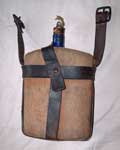
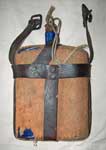
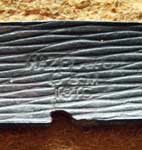 The Pattern 1914 Water bottle carrier was introduced with the Infantry Equipment, Pattern 1914 in List of Changes entry L. of C. 16977, dated 30th August 1914. It is designed to carry the Mk. V or Mk. VI Water bottle. As with all leather parts of the Pattern Pattern 1914 Infantry Equipment, the colour was changed from Service Dress to London brown by List of Changes entry L. of C. 17219, with acceptance dates 31st December 1914 and 30th March 1915. Except for the colour, the Water bottle carrier remained unchanged throughout its service life. This example is dated 1915 and is interestingly maker marked "Hazel & Co., C. & M." Hazel & Co. were the successors to old-line leather accoutrements makers Hebbert & Co.. When Web Equipment, Pattern 1908 was introduced, David Hazel, the Managing Director for Hebberts, immediately saw the handwriting on the wall. He contacted Mills and Hebberts became M.E. Co. agents for the Territorial Associates outside the immediate London area. Shortly thereafter, he rolled up Hebberts and reorganised as Hazel & Co.. One occasionally sees pre-war Mills made Patt. '08 equipment marked "Hazel & Co." instead of "M.E. Co." WWI advertisements for Hazel & Co. show that they remained Mills agents throughout the war. From the Chris Pollendine Collection, photos © Chris Pollendine 2011.
The Pattern 1914 Water bottle carrier was introduced with the Infantry Equipment, Pattern 1914 in List of Changes entry L. of C. 16977, dated 30th August 1914. It is designed to carry the Mk. V or Mk. VI Water bottle. As with all leather parts of the Pattern Pattern 1914 Infantry Equipment, the colour was changed from Service Dress to London brown by List of Changes entry L. of C. 17219, with acceptance dates 31st December 1914 and 30th March 1915. Except for the colour, the Water bottle carrier remained unchanged throughout its service life. This example is dated 1915 and is interestingly maker marked "Hazel & Co., C. & M." Hazel & Co. were the successors to old-line leather accoutrements makers Hebbert & Co.. When Web Equipment, Pattern 1908 was introduced, David Hazel, the Managing Director for Hebberts, immediately saw the handwriting on the wall. He contacted Mills and Hebberts became M.E. Co. agents for the Territorial Associates outside the immediate London area. Shortly thereafter, he rolled up Hebberts and reorganised as Hazel & Co.. One occasionally sees pre-war Mills made Patt. '08 equipment marked "Hazel & Co." instead of "M.E. Co." WWI advertisements for Hazel & Co. show that they remained Mills agents throughout the war. From the Chris Pollendine Collection, photos © Chris Pollendine 2011.
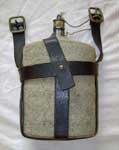
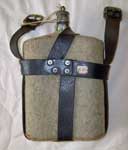
 Another example of the Carrier, water bottle. Dated 1915, as is the example above, but maker marked "Wells & Co." Of particular interest is the Water bottle itself. Instead of the enameled steel Bottle, water, Mk. VI, the standard issue Bottle of WWI, this is an example of the electro plated nickel alloy bodied Bottle, water, Pattern 1915, dismounted services. From the Chris Pollendine Collection, photos © Chris Pollendine 2011.
Another example of the Carrier, water bottle. Dated 1915, as is the example above, but maker marked "Wells & Co." Of particular interest is the Water bottle itself. Instead of the enameled steel Bottle, water, Mk. VI, the standard issue Bottle of WWI, this is an example of the electro plated nickel alloy bodied Bottle, water, Pattern 1915, dismounted services. From the Chris Pollendine Collection, photos © Chris Pollendine 2011.
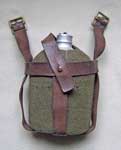
 This Carrier is interesting because it is actually dated 1914, which makes it one of the earliest pieces of Patt. '14 KW have seen. It is maker marked ". Davis & Co." One fact that is curious for such an early date is the colour. It appears to be London Brown, rather than Service Dress, and it doesn't look to have been much darkened by usage or oiling, etc. Perhaps another clue that the amount of Patt. '14 equipment actually produced in Service Dress was very small indeed. The Bottle is interesting, too. Also 1914 dated, it is an example of the Bottle, water, aluminium (Canadian pattern). This was a WWI design manufactured by the Canadian Aluminium Goods Company. In their article British and Empire Waterbottles 1750 - 2005, published in The Armourer magazine in six parts from January to December, 2006, Rog Dennis and John Bodsworth had this to say about the Canadian pattern Bottle, "Most frequently seen being worn with Pattern 1914 Infantry Equipment, another of the expedient introductions to equip the huge New Armies being formed." Owned by a British collector who wishes to remain anonymous.
This Carrier is interesting because it is actually dated 1914, which makes it one of the earliest pieces of Patt. '14 KW have seen. It is maker marked ". Davis & Co." One fact that is curious for such an early date is the colour. It appears to be London Brown, rather than Service Dress, and it doesn't look to have been much darkened by usage or oiling, etc. Perhaps another clue that the amount of Patt. '14 equipment actually produced in Service Dress was very small indeed. The Bottle is interesting, too. Also 1914 dated, it is an example of the Bottle, water, aluminium (Canadian pattern). This was a WWI design manufactured by the Canadian Aluminium Goods Company. In their article British and Empire Waterbottles 1750 - 2005, published in The Armourer magazine in six parts from January to December, 2006, Rog Dennis and John Bodsworth had this to say about the Canadian pattern Bottle, "Most frequently seen being worn with Pattern 1914 Infantry Equipment, another of the expedient introductions to equip the huge New Armies being formed." Owned by a British collector who wishes to remain anonymous.

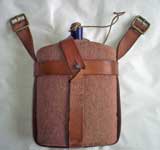
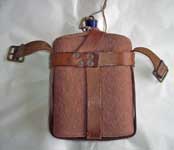 Another example of the Water bottle carrier in London Brown. This example is important because the Bottle and its Carrier were stored in a closed trunk from the end of the Great War until quite recently, and obviously saw little or no action before then. We believe this Carrier to be about as close as it is possible to get to the original London Brown colour. The maker's mark is unclear, but it is dated 1915. From the Steve Hewitt Collection, photographs © Steve Hewitt 2011.
Another example of the Water bottle carrier in London Brown. This example is important because the Bottle and its Carrier were stored in a closed trunk from the end of the Great War until quite recently, and obviously saw little or no action before then. We believe this Carrier to be about as close as it is possible to get to the original London Brown colour. The maker's mark is unclear, but it is dated 1915. From the Steve Hewitt Collection, photographs © Steve Hewitt 2011.
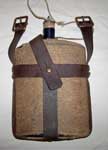
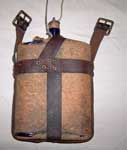
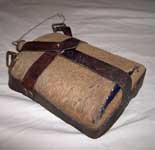
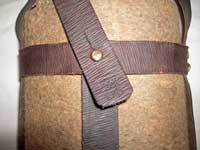 An American made example of the Water bottle carrier. This Carrier is maker marked "Cook" and dated 1914. From the Chris Pollendine Collection, photos © Chris Pollendine 2011.
An American made example of the Water bottle carrier. This Carrier is maker marked "Cook" and dated 1914. From the Chris Pollendine Collection, photos © Chris Pollendine 2011.